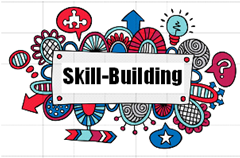- Home
- Curriculum
- Curriculum Subjects
- Languages (Spanish)
- 1. What does Spanish look like at All Saints'?
1. What does Spanish look like at All Saints'?

At All Saints’, our Spanish curriculum is structured on the aims of the National Curriculum and linked to our wider curriculum topics and liturgical calendar in each year group, to ensure relevancy and context. All of the elements and skills are covered within each Key Stage cluster – Early Years, Key Stage 1, Lower Key Stage 2, Upper Key Stage 2. These elements are: singing, creating, drawing, painting, sculpture, textiles, digital media and collage.
Spanish starts at All Saints’ from EY singing Spanish nursery rhymes (through two official music methods: El Pequeño Caracolito and Batucado) where they start to be familiar with greetings and basic vocabulary. In Year 1 and Year 2, the students learn Spanish through songs linked to topics that Year 3 are learning. The students start to get familiar with vocabulary, accent, rhymes and when they get to Year 3, KS2, students are confident and enjoy the learning more. In KS2 students deepen their understanding of Spanish. In Year 3 the children are taught key language. From Year 4 till Year 6, students will learn how to build the grammar and structure of the language, for them to apply in the future and reinforce their communication skills and having conversations.
A Spanish scheme is taught by one unit, with 3-4 schemes, per term unless the complexity of the unit scheme requires more time. As part of each unit of work, the children have the opportunity to experiment and develop their speaking, listening, writing skills to produce a final outcome. More detail can be found on our long-term plan. The works of culture, gastronomy, festival and celebrations are explored in depth to enhance the children’s knowledge of historical and cultural development of Spanish language and culture.
The pillars of our Spanish lessons are singing and movement, as children are learning vocabulary and difficult concepts through different sensory inputs: movement, visual and listening. This way guarantee fun learning and create a secure space for creativity and exploring, a safe space to speak and create conversations where mistakes are welcome and is part of our learning journey. The content progressively focusses upon grammatical understanding, learning basic grammar which is appropriate to the language. The content is intended to be both memorable and engaging, with a focus upon songs, rhyme and actions throughout the delivery of units, to aid understanding.
Our competencies are: speaking, listening, writing and reading. We prioritize speaking and listening first as we want our students to be able to communicate verbally their ideas, thoughts and needs and to understand others, building in that way their confidence and self-steam speaking in another language than writing and reading. When our students feel confident, we teach them how to write what they have said and read it. Children love sharing their ideas, likes and dislikes with their teacher and friends.
At All Saints’, all children in Key Stage Two will have a individual Spanish book where pupils reflect on their weekly work. Students also use their Spanish book to look for vocabulary and information, as every lesson, the first 10–15 minutes are just speaking remembering all the concepts they have learnt in lovely and nice conversations with each other. It is encouraged as a place to experiment and take risks, without the fear of doing ‘wrong’.
To learn another language develops habits, behaviour, resilience, respect for other culture, empathy for others, patience, values and attitudes to be successful in Spanish and other aspects of our lives.
‘Creativity is inventing, experimenting, growing, taking risks, breaking rules, making mistakes, and having fun.’ – Mary Lou Cook.

- Learn the vocabulary, keywords and language expressions throughout songs, listening through dialogues and speeches from real native speakers.
- Encourage children to be an active participant in speaking and listening modelled by the teacher, using activities like 'partner talk' and from there, engage them to have conversations where the students will be able to use vocabulary previously learnt.


- Through writing and speaking activities, students will be able to reinforce the new vocabulary, spelling rules and the grammar learnt plus the Spanish punctuation marks, as well as the importance of presenting the written work clean, neat and tidy.
- Structure of conversations.
- To ask and answer different types of questions verbally.


- The students will have the opportunity to reflect their knowledge independently through verbal or written activities, where they will be able to apply their learning to express their wishes and facts about them.
